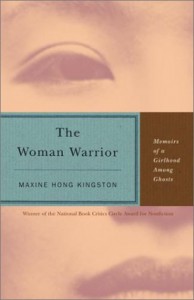Nicole~

The Swordswoman of Words
'The Woman Warrior' is Maxine Hong Kingston's own story of growing up Chinese-American, an irreconcilable position for her as the two cultures would seemingly clash, unable to provide her with a stable sense of identity. She grew up confused by the ideas and behavior of her parents and the villagers who had settled in Stockton, California, who saw their American-born children as very strange - not really Chinese. Her parents hoped one day to return the whole family to China - yet the China they had left had since changed. All she knew of the place she had never been, was through the 'talk-stories' told by her mother; parables in the Chinese tradition of telling magical stories and incorporating them into their everyday life; of ancestors and relatives, and great tales of mythic and cultural heroines.
Her mother was exceedingly gifted in talking-story:
"Night after night my mother would talk-story until we fell asleep. I couldn't tell where the stories left off and the dreams began, her voice the voice of heroines in my sleep. And on Sundays, from noon to midnight, we went to movies at the Confucius Church. We saw swordswomen jump over houses from a standstill; they didn't even need a running start.
At last I saw I too had been in the presence of great power, my mother talking- story. After I grew up, I heard the chant of Fa Mu Lan, the girl who took her father's place in battle. I had forgotten this chant...given me by my mother, who may not have known its power to remind. She said I would grow up a wife and a slave, but she taught me the song of the warrior woman, Fa Mu Lan. I would have to grow up a warrior woman".
In 'The Woman Warrior', MHK constructs her own identity and the meaning of her life. She places herself as the primary narrator in stories artistically woven with Chinese myth and legend, including other women characters- some known and unknown, real and imagined. The stories are highly imaginative; the narrative flows with wondrous elements of magical-realism.
The book is sectioned into five chapters, illustrating MHK's American experience: 'No Name Woman' tells the story of her aunt who was ostracized for having an illegitimate child; 'White Tigers' weaves the story of Fa Mu Lan- the mythical character to whom MHK most relates- who goes to battle in her father's stead and saves a village; 'Shaman' tells the story of her mother, Brave Orchid, becoming a doctor in the old country and her immigration to America; 'At The Western Palace' covers her mother's sister, Moon Orchid, in her journey to California in the hope of reconciling with her estranged husband; 'A Song for A Barbarian Reed Pipe' reflects a poignant message of preservation of an ebbing culture and a melding of the current ones.
MHK would often rebel against the stringent Chinese-feminine model : "I refused to cook. When I had to wash dishes, I would crack one or two. 'Bad girl,' my mother yelled, and sometimes that made me gloat rather than cry. Isn't a bad girl almost a boy?" She knew that she must become a warrior woman- strong, independent, a fighter, a burden to no one. She would not be silenced.She confessed to her mother that she, too, could 'talk-stories;' and how immeasurably gifted she was at that!
Her power was wielded in language, her 'loosened tongue', her voice; her sharpened pen became her sword, her strength.
In an interview in the Atlantis publication jun-nov 1988, Maxine Hong Kingston explained that she took care to find the force of reason within her stories, the middle ground between the real world and the supernatural. 'The Woman Warrior' was a vehicle for the many voices MHK heard within herself. She hoped that her writings would give a voice to Chinese-American women, and that their everyday existence growing up in America within a traditional Chinese culture, would be seen with more compassion and understanding, with a bright look toward a balanced resolution. For MHK herself, 'The Woman Warrior' finally reconciled those clashes of the two cultures, to the formation of a beautiful, enduring, identifiable new one.
 1
1



